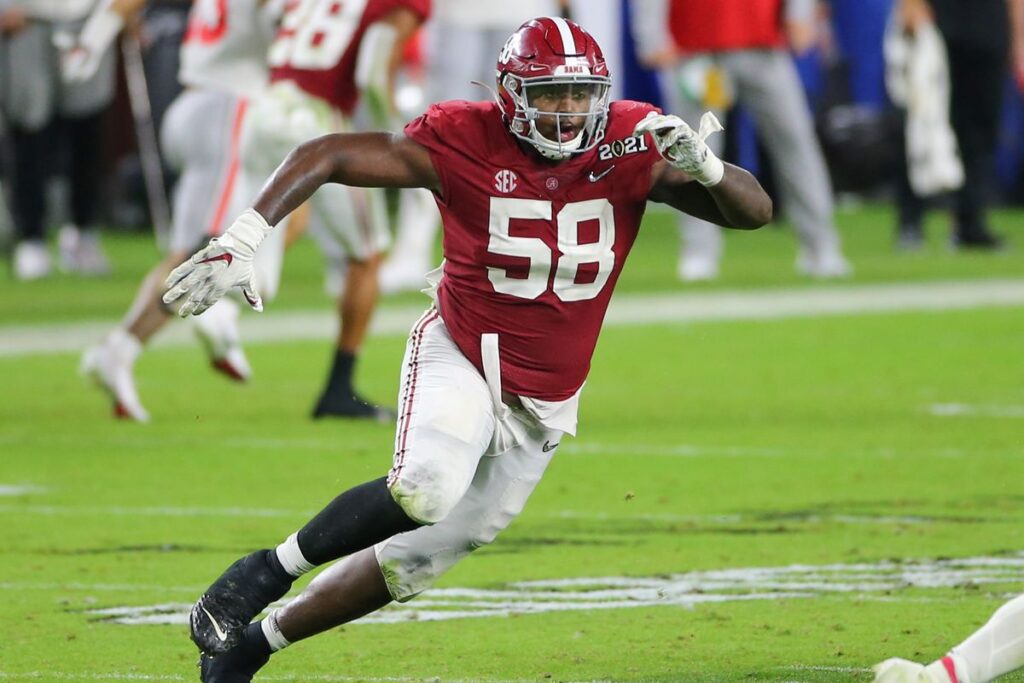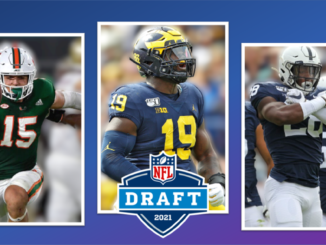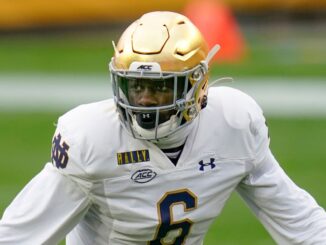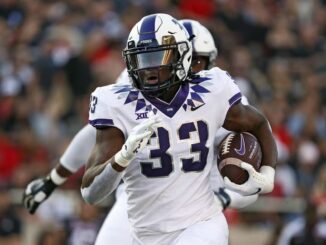The first round of the 2021 NFL Draft is in the books, but there is still plenty of talent available. As is often the case we saw a number of big names fall out of the top 32. Here are my top ten players remaining in this year’s draft.
Jeremiah Owusu-Koramoah – LB, Notre Dame

Big Board Rank: #12, LB2
Pros: Owusu-Koramoah is the best coverage linebacker in the 2021 class. He has all of the athletic ability you could want at the position and could plausibly transition to a full-time safety role in the NFL. He is a smooth mover in coverage, with fluid hips and the ability to turn and run with receivers. Notre Dame often asked him to move out to the slot in man coverage and he proved capable of sticking with shiftier slot receivers. Owusu-Koramoah is really explosive and has excellent short area burst. Despite not being the biggest linebacker he was an effective blitzer in college and made his presence known in the backfield. He is a hard hitter and was responsible for six forced fumbles during his time in South Bend.
Cons: At just 6’1″ and 221 lbs, Owusu-Koramoah is small for a linebacker and could struggle to transition to the more physical aspects of the NFL game. He played the ‘overhang’ role in the Notre Dame defense which doesn’t really translate to a traditional inside linebacker role at the next level. He can also sometimes be a little bit over-eager to make plays which leads to him taking poor pursuit angles and overrunning the ball carrier. Owusu-Koramoah isn’t a bad tackler, but he could certainly be more reliable and can struggle to wrap up in space.
Christian Barmore – IDL, Alabama

Big Board Rank: #15, IDL1
Pros: Barmore is a powerful interior lineman, with really strong hands. He combines this with legitimate explosiveness and showcases great initial burst. Despite being a big guy, he plays with consistently excellent leverage and bends better than most interior linemen. Although his sample size is fairly small he has been the most disruptive interior lineman in college football over the past two years. Barmore has registered 65 pressures and 11 sacks across 492 pass rushing snaps over the last two years. His best games actually came against top competition and he had 12 pressures in his final two games against Notre Dame and Ohio State.
Cons: Barmore only became a full-time starter for Alabama in 2020, having played just 269 snaps in 2019. His sample size is amongst the smallest in this class, with just 747 career snaps. Whilst he has shown the ability to be a game-wrecker, his game-to-game consistency is not where it could be. There were several occasions where he went missing, most notably against Florida and Tennessee. Barmore has been an excellent pass rusher, but at this point he doesn’t offer the same ability against the run. His technique could certainly improve and he tends to play tall.
Elijah Moore – WR, Ole Miss

Big Board Rank: #19, WR4
Pros: Moore is an excellent slot receiver, with elite short area burst and long speed to test defenses over the top. He was one of the most productive players in college football in 2020, leading the FBS with 149.1 receiving yards per game. He is excellent after the catch too, averaging 5.9 yards per reception and forcing 18 missed tackles on his 86 catches in 2020. Despite being a smaller receiver, Moore demonstrates real toughness and is surprisingly effective in contested catch situations, with a 73 per cent success rate. This is higher than the likes of Tylan Wallace and Ja’Marr Chase, both known for their dominance at the catch point. He also offers great hands, with just two drops on 88 catchable passes in 2020.
Cons: Whilst Moore has the toughness to potentially hold up as a boundary receiver, he played the vast majority of collegiate snaps in the slot. As a result, he didn’t have to face press coverage very often. This will change in the NFL and how he will deal with physicality at the line remains something of an unknown. At 5’9″ and 178 lbs, Moore is also on the smaller end of what you want from a receiver. Whilst his collegiate production was impressive, the numbers were boosted by schemed production on slants and crossing routes across the middle of the field.
Trevon Moehrig – S, TCU

Big Board Rank: #20, S1
Pros: Moehrig is a fantastic athlete, with the range you want in a safety. He is comfortable in single-high or split-safety looks and also offers slot cornerback versatility. Moehrig possesses fluid hips and great change of direction ability and has no issue when asked to turn and run with a receiver. TCU’s quarters-heavy defense often saw him play in man coverage against slot receivers and tight ends and he held his own. Moehrig is one of the best ball hawks in this year’s class and he logged a forced incompletion rate of 29.1 per cent throughout his career. This is the third highest rate in this year’s safety class. He was consistently productive throughout his three years as a starter and allowed a passer rating of just 54.7 in his college career.
Cons: Whilst Moehrig is excellent in coverage, the same can’t be said for his run defense. He is often over-aggressive when coming downhill and this leads to him taking poor pursuit angles and overrunning the play. This also makes tackling more of a challenge and he has had issues wrapping up consistently. Moehrig had a 14.3 per cent miss rate throughout his time at TCU and needs to improve on his technique. At the moment he tends to launch himself at the ball carrier, rather than using proper form.
Teven Jenkins – OT, Oklahoma State

Big Board Rank: #21, OT4
Pros: Jenkins is one of the strongest tackles in the class and is a mauler in the running game. He has great power at the point of attack and showcases the independent hand usage you want in a tackle prospect. There were a tonne of reps on tape where he would get hold of an opponent and take them for a ride. He is a nasty finisher too and teams will like his tough attitude. In pass protection he is solid, allowing just 11 pressures on 623 pass blocking snaps since the start of 2019. Jenkins is comfortable working against stunts and blitzes and has split his time between left and right tackle at Oklahoma State.
Cons: Jenkins isn’t the most dynamic athlete. He can struggle to get depth out of his stance on vertical sets and this leaves him vulnerable to quicker edge rushers. Despite being one of the strongest tackle prospects in the class, his lower half isn’t as powerful as you would like and he can have issues anchoring against power. Oklahoma State’s Air Raid offense didn’t ask him to play anywhere near as many vertical sets as he will in the NFL and rarely left him one-on-one with an edge. By virtue of playing in the Big 12 he didn’t face much in terms of top edge rushing talent either.
Asante Samuel Jr. – CB, Florida State

Big Board Rank: #23, CB3
Pros: Samuel is a really smooth mover at corner, with some of the best change of direction ability you will see. His short area quickness is noteworthy and he is quick out of his breaks. Samuel is one of the best ball hawks in this year’s class and his instincts are rare, logging a 19.7 per cent forced incompletion rate during his time at Florida State. His 2020 tape was particularly impressive, and Samuel allowed just 179 yards on his 32 targets, giving up a passer rating of 46.2. Despite lacking prototypical size, Samuel gives his all as a run defender and does a nice job of coming downhill and engaging with the ball carrier.
Cons: At just 5’10” and 180 lbs, Samuel is seriously undersized for the position. He played primarily as a boundary corner in college, but teams may look to switch him to the slot at the next level. Unsurprisingly he lacks ideal physicality and can struggle when tasked with covering bigger receivers. His lack of size and length lead him to struggle in press coverage and he will likely only have success in an off coverage-heavy scheme. Samuel isn’t always the most reliable tackler either and his lack of length and functional strength make this more difficult. He had a 13.8 per cent miss rate throughout his college career.
Rondale Moore – WR, Purdue

Big Board Rank: #27, WR6
Pros: Moore is one of the most electric receivers with the ball in his hands. 70.2 per cent of his collegiate yards came after the catch. He has excellent change of direction ability and speed that few others can match, running a 4.29 40-yard dash. Despite not being the biggest receiver, he is incredibly tough and shows great contact balance. Moore has forced 53 missed tackles on 208 career touches, a rate that would not be out of place for a running back. His ball skills are excellent too, with soft hands and the ability to make catches outside his frame. He has shown that he can produce in a high-volume role, with 114 catches for 1,258 yards as a true freshman in 2018.
Cons: At just 5’7″, some teams will have concerns about Moore’s lack of height and his ability to translate to the NFL game. There will also be questions about his sample size. Moore’s production in 2018 was elite, but he has played just seven games since then. His injury issues have been somewhat overstated, but the lack of tape since his true freshman season has to be a concern. The other issue will be his limited route tree. Purdue used him heavily as an underneath receiver, with 39 per cent of his receptions coming behind the line of scrimmage. Just 24 of his 178 career receptions have come 10+ yards downfield.
Azeez Ojulari – EDGE, Georgia

Big Board Rank: #29, EDGE4
Pros: Ojulari is the best pure speed rusher in this class. He showcases great initial burst and has the ability to consistently test the outside shoulder of tackles. He plays with great bend and does a nice low of staying low throughout the rep. His length is a major plus and allows him to keep opponents from getting inside his frame. His cross-chop move is particularly effective and was a major part of his success in 2020. Ojulari was the most productive pass rusher on a per-snap basis in this year’s class, finishing with 37 pressures on just 193 pass rushing snaps. He also offers the versatility to drop off and play in coverage.
Cons: At 6’2″ and 249 lbs he is on the smaller end of what you want in an NFL edge rusher. Whilst his speed and quickness helped him have great success in college, he remains a little one-dimensional with his pass rush plan. Ojulari is always looking to attack the outside shoulder of opponents and will need to do a better job of diversifying his attack at the next level. He displays good effort against the run but lacks the functional strength to stand in against bigger blockers. He benefitted from Georgia’s rotational edge lineup and was kept fresh, averaging just 37.5 snaps per game in 2020.
Samuel Cosmi – OT, Texas

Big Board Rank: #31, OT5
Pros: Cosmi is an incredible athlete and moves like a tight end in space. Texas even used him as a receiver on a screen pass for a touchdown back in 2019. He is a polished pass protector and has allowed just 47 pressures on his 1,529 pass blocking snaps. His 90.7 PFF pass blocking grade ranked third amongst all college football tackles in 2020. He has the movement skills to handle speed off the edge and does a great job of opening his hips and taking rushers around the pocket. He is a pretty solid run blocker too, with good power at the point of attack and the movement skills to get up to the second level.
Cons: At 6’6″, Cosmi is one of the taller tackles in the class and he often struggles to stay low in pass protection. His pad level could certainly improve and it often leaves him vulnerable to the bull rush. He isn’t as strong as you might like, particularly as a run blocker, but he has the size to add more weight to his frame. Cosmi can sometimes rely too much on opening his hips and taking pass rushers around the pocket and as a result he can be beaten by inside counters. Despite his height, he doesn’t possess ideal tackle length, with just 33″ arms.
Nick Bolton – LB, Missouri

Big Board Rank: #33, LB3
Pros: Bolton’s instincts and processing speed makes him one of the best linebackers in this year’s class. He isn’t the biggest player, but he is a hard hitter who loves getting downhill and making plays. He excels in run defense, with the lateral agility to shut down plays anywhere on the field. His 77 run stops since 2019 are the second most by any Power Five linebacker. He is also surprisingly effective in coverage given his average athletic profile. Bolton led all FBS linebackers with a 90.2 PFF coverage grade in 2019 and has accounted for 13 forced incompletions over the last two seasons.
Cons: When it comes to measurables, Bolton doesn’t stand up well when compared to his fellow classmates. At just 5’11” and 237 lbs he is on the small end of what you want in a linebacker. He can often get stuck on blocks as a result and his lack of length can cause issues when tackling. He also lacks the elite athleticism of players like Parsons and Owusu-Koramoah and his change of direction ability isn’t great. As a result there will be concerns about whether or not he will be able to translate his success in coverage to the next level.


